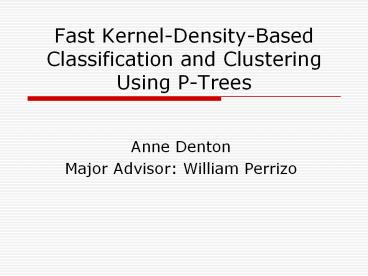Fast Kernel-Density-Based Classification and Clustering Using P-Trees PowerPoint PPT Presentation
Title: Fast Kernel-Density-Based Classification and Clustering Using P-Trees
1
Fast Kernel-Density-Based Classification and
Clustering Using P-Trees
- Anne Denton
- Major Advisor William Perrizo
2
Outline
- Introduction
- P-Trees
- Concepts
- Implementation
- Kernel Methods
- Paper 1 Rule-Based Classification
- Paper 2 Kernel-Based Semi-Naïve Bayes Classifier
- Paper 3 Hierarchical Clustering
- Outlook
3
Introduction
- Data Mining
- Information from data
- Considers storage issues
- P-Tree Approach
- Bit-column-based storage
- Compression
- Hardware optimization
- Simple index construction
- Flexibility in storage organization
4
P-Tree Concepts
- Ordering (details)
- New Generalized Peano order sorting
- Compression
5
Impact of Peano Order Sorting
6
P-Tree Implementation
- Implementation in Java
- Was ported to C / C (Amal Perera, Masum Serazi)
- Fastest compressing P-tree implementation so far
- Array indices as pointers (details)
- Grandchild purity
7
Kernel-Density-Based Classification
- Probability of an attribute vector x
- Conditional on class label value ci
- ? is 1 if ? is true, 0 otherwise
- Depending on N training points xt
- Kernel function K(x,xt) can be, e.g., Gaussian
function or step function
8
Higher Order Basic Bit Distance HOBbit
- P-trees make count evaluation efficient for the
following intervals
9
Paper 1 Rule-Based Classification
- Goal High accuracy on large data sets including
standard ones (UCI ML Repository) - Neighborhood evaluated through
- Equality of categorical attributes
- HOBbit interval for continuous attributes
- Curse of dimensionality
- Volume empty with high likelihood
- Information gain to select attributes
- Attributes considered binary, based on test
sample (Lazy decision trees, Friedman 96 4) - Continuous data Interval around test sample
- Exact information gain (details)
- Pursuing multiple paths
10
Results Accuracy
C4.5 20 paths
adult 15.54 14.93
kr-vs-kp 0.8 0.84
mushroom 0 0
- Comparable to C4.5
- after much less
- development time
- 5 data sets from UCI
- Machine Learning
- Repository (details)
- 2 additional data sets
- Crop
- Gene-function
- Improvement through
- multiple paths (20)
11
Results Speed
- Used on largest UCI data sets
- Scaling of execution time as a function of
training set size
12
Paper 2 Kernel-Based Semi-Naïve Bayes Classifier
- Goal Handling many attributes
- Naïve Bayes
- x(k) is value
- of kth attribute
- Semi-naïve Bayes
- Correlated attributes are joined
- Has been done for categorical data
- Kononenko 91 5, Pazzani 96 6
- Previously Continuous data discretized
13
Kernel-Based Naïve Bayes
- Alternatives for continuous data
- Discretization
- Distribution function
- Gaussian with mean
- and standard
- deviation from data
- No alternative for
- semi-naïve approach
- Kernel density
- estimate (Hastie 7)
14
Correlations
- Correlation between
- attributes a and b
- N Number of
- training points t
- Kernel function for
- continuous data
- dEH Exponential HOBbit distance
15
Results
- P-tree Naïve Bayes
- Difference only for
- continuous data
- Semi-Naïve Bayes
- 3 parameter
- combinations
- Blue t 1
- 3 iterations
- Red t 0.3
- incl. anti-corr.
- White t 0.05
- (t threshold)
16
Paper 3 Hierarchical Clustering 10
- Goal
- Understand relationship between standard
algorithms - Combine the best aspects of three major ones
- Partition-based
- Relationship to k-medoids 8 demonstrated
- Same cluster boundary definition
- Density-based (kernel-based, DENCLUE 9)
- Similar cluster center definition
- Hierarchical
- Follows naturally from above definitions
17
Results Speed Comparison with K-Means
18
Results Clustering Effectiveness
K-means
Our Algorithm
19
Summary
- P-tree representation for non-spatial data
- Fast implementation
- Paper1 Rule-Based Algorithm
- Test-sample-centered intervals, multiple paths
- Competitive on standard (UCI) data
- Paper 2 Kernel-Based Semi-Naïve Bayes
- New algorithm to handle large attribute numbers
- Attribute joining shown to be beneficial
- Paper 3 Hierarchical Clustering 10
- Competitive for speed and effectiveness
- Hierarchical structure
20
Outlook
- Software engineering aspects
- Column-oriented design
- Relationship with P-tree API
- Non-standard data
- Data with graph structure
- Hierarchical data, concept slices 11
- Visualization
- Visualization of data on a graph
21
Software Engineering
- Business-problems row-based
- Match between database tables and objects
- Scientific / engineering problems column-based
- Collective properties of interest
- Standard OO unsuitable, instead
- Fortran
- Array-based languages (ZPL)
- Solution?
- Design pattern?
- Library?
22
Ptree API
23
Non-standard Data
- Types of data
- Biological (KDD-cup 02 Our team got honorary
mention!) - Sensor Networks
- Types of problems
- Small probability of minority class label
- A-ROC Evaluation
- Multi-valued attributes
- Bit-vector representation ideal for P-trees
- Graphs
- Rich supply of new problems / techniques (work
with Chris Besemann) - Hierarchical categorical attributes 11
24
Visualization
- Idea
- Use graph visualization tool
- E.g. http//www.touchgraph.com/
- Visualize node data through glyphs
- Visualize edge data

